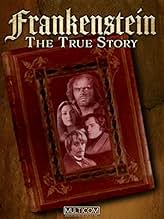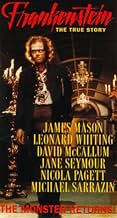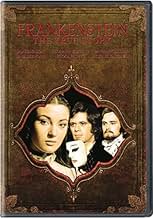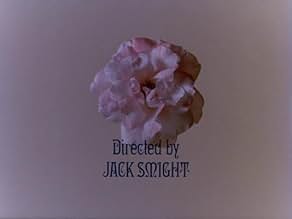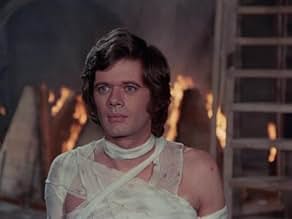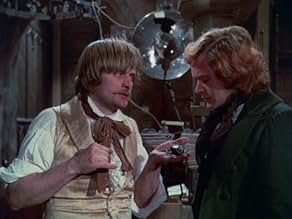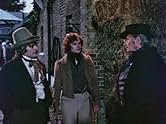Agrega una trama en tu idiomaWhen the brilliant but unorthodox scientist Dr. Victor Frankenstein rejects the artificial man that he has created, the Creature escapes and later swears revenge.When the brilliant but unorthodox scientist Dr. Victor Frankenstein rejects the artificial man that he has created, the Creature escapes and later swears revenge.When the brilliant but unorthodox scientist Dr. Victor Frankenstein rejects the artificial man that he has created, the Creature escapes and later swears revenge.
- Premios
- 1 nominación en total
- Lady Fanshawe
- (as Clarissa Kaye)
- Dirección
- Guionistas
- Todo el elenco y el equipo
- Producción, taquilla y más en IMDbPro
Argumento
¿Sabías que…?
- TriviaThe character "Dr. Polidori" is not in Mary Shelley's novel, although he includes elements of Victor Frankenstein's mentors, Doctors Waldman and Krempe. He is primarily based on Dr. Septimius Pretorius from La novia de Frankenstein (1935), but the name had to be changed because the Pretorius character is not in the public domain. He is named for Shelley's friend John William Polidori, who wrote a novella called "The Vampyre," which he began in the same weekend that she got the idea to write "Frankenstein". Polidori served as doctor for Lord Byron, who mockingly called him "Pollydolly", just like Clerval does in the film.
- ErroresWhen Polidori introduces Victor to the creature in his carriage, the interior point of view shot shows a Chinese servant closing the carriage door. A split second later, in a reverse angle shot from the exterior, the servant has vanished.
- Citas
Dr. Henry Clerval: You're afraid. I was afraid at first. It's the way we've been brought up. We've been brought up to fear! To fear the punishment of the gods. But Prometheus defied them.
Dr. Victor Frankenstein: And they punished him!
Dr. Henry Clerval: He scorned their punishment. So has every other hero that's stolen secrets from nature to give to mankind.
- Versiones alternativasThe widely seen version features a prologue with James Mason visiting the supposed grave of Mary Shelley. However, test screenings showed a longer prologue, depicting Mary Shelley and her friends coming up with the Frankenstein story at a Swiss villa, similar to the opening of La novia de Frankenstein (1935). This was cut and replaced by the simpler version after the test audiences were bored by it.
- ConexionesFeatured in Der phantastische Film: Frankenstein, wie er wirklich war 1 (1980)
True Story owes little to previous movie versions, neither the mossy old 1930's and 'forties Universal Frankenstein series or Hammer's 1950's/'60's revivals, but is a completely fresh approach. The brilliant script by Isherwood and Bachardy is almost as literary as Mrs. Shelly novel, yet even more exciting and stimulating. True Story is a splendid production, probably one of the most handsomely turned out made-for-TV numbers of all time. Period (1797 and following) sets and costumes are exquisite. The cinematography is beautiful, belying its TV origins every step of the way. Unlike most TV movies of the time and practically all current theatrical movies, it disdains the shot-a-second montage method in favor of the mise-en-scene approach -- every scene starts with a precisely composed long shot, which gradually pans in to close-up. This classic style of cinematography complements the beautiful sets, enhances the melancholy mood, and displays the humanity of the characters better than montage. Here it is used brilliantly by director of photography Arthur Ibbetson and director Jack Smight.
Frankenstein: The True Story is expertly acted by Mason, Leonard Whiting (Victor), Nicole Padget (Elizabeth), Michael Sarrizan (Creature), Jane Seymour (female creature) and the rest of a fine cast. It is dramatically engaging, thoroughly engrossing for its entire three hours, intellectually stimulating, and gorgeously filmed. A delight from beginning to end. Even Old Hollywood would have been proud to have turned out such a complete motion picture.
P.S. -- Those who are interested in learning more about that early 19th century femme fa-tale and the origin of her famous monster story would do well to read Miranda Seymour's superbly researched, highly readable biography of Mary Shelly (Grove Press, NY, 2000).
- oldblackandwhite
- 12 ene 2017
- Enlace permanente
Selecciones populares
Detalles
- Fecha de lanzamiento
- Países de origen
- Sitio oficial
- Idiomas
- También se conoce como
- Frankenstein, wie er wirklich war
- Locaciones de filmación
- Productora
- Ver más créditos de la compañía en IMDbPro
- Tiempo de ejecución3 horas 5 minutos
- Mezcla de sonido
Contribuir a esta página


